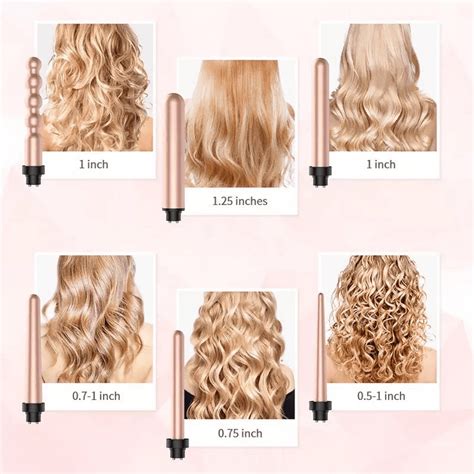1. Wand Curling Iron: The Versatile All-Rounder
- Wand curling irons, also known as barrel curling irons, feature a long, cylindrical barrel that evenly distributes heat for uniform curls.
- Available in various barrel sizes (0.5-1.5 inches), they cater to a wide range of curl preferences, from tight ringlets to loose waves.
- Ideal for beginners and professionals alike, wand curling irons offer maximum control and customization.
2. Clip Curling Iron: Precision and Ease
- With a clamp that holds hair securely, clip curling irons create defined and polished curls.
- The barrel is usually shorter than wand curling irons, enhancing precision and making it perfect for smaller sections of hair.
- Suitable for all hair types, clip curling irons are particularly effective for thick or dense hair, providing even heat distribution.
3. Cone Curling Iron: Graduated Curls, Effortless Volume
- Cone curling irons feature a barrel that narrows towards the tip, creating curls that gradually transition from tight to loose.
- The tapered design adds volume and depth to curls, making it popular for glamorous and feminine styles.
- Ideal for long hair, cone curling irons can create everything from voluminous waves to cascading curls.
4. Interchangeable Curling Iron: Versatility at Your Fingertips
- Interchangeable curling irons comprise a handle and a variety of barrels that can be attached and detached.
- This allows for maximum versatility, enabling users to create a diverse range of curls with a single tool.
- Interchangeable curling irons are ideal for those who prefer to experiment with different curl types and styles.
5. Spiral Curling Iron: Corkscrew Perfection
- Spiral curling irons feature a barrel with helical grooves that create tight, corkscrew-like curls.
- The spiral design ensures even heat distribution, resulting in defined and frizz-free curls.
- Suitable for all hair types, spiral curling irons are popular for creating long-lasting, dramatic curls.
- Curl Definition: Different curling iron types produce varying levels of curl definition, from tight, springy curls to loose, flowing waves.
- Hair Volume: Cone curling irons, for example, can add significant volume to hair, while clip curling irons may provide a more natural, polished look.
- Curl Longevity: Spiral curling irons are known for creating long-lasting curls that can withstand humidity and movement.
- Hair Health: Choosing a curling iron with temperature control and ceramic or tourmaline barrels helps protect hair from heat damage.
- Prep your hair: Before curling, prep your hair with heat protectant spray to minimize damage.
- Use the right temperature: Adjust the heat setting based on your hair type; higher temperatures for thick hair, lower temperatures for fine hair.
- Section your hair: Divide your hair into smaller sections for even heat distribution and controlled curls.
- Hold the curling iron horizontally: Holding the curling iron parallel to the ground ensures consistent heat on the hair.
- Roll slowly and carefully: Gently roll the hair away from your face for curls that face outward or towards your face for curls that face inward.
- Cool down your curls: Allow your curls to cool before brushing them to prevent them from losing their shape.
- What is the best type of curling iron for beginners? Wand or clip curling irons are recommended for beginners due to their ease of use and control.
- How often should I curl my hair? To avoid heat damage, limit curling your hair to once or twice a week.
- What size curling iron should I use for long hair? For long hair, consider using a curling iron with a barrel size between 1.25-1.5 inches to create loose, voluminous curls.
- Can I use a curling iron on wet hair? Avoid using a curling iron on wet hair, as this can cause steam damage and frizzy curls.
- How do I curl my hair without heat? Use heatless curling methods such as foam rollers, braids, or overnight hair wraps to achieve curls without damaging your hair.
- Can I use a curling iron on extensions? Yes, but use a lower heat setting and be cautious as extensions may be more prone to heat damage.
- How do I clean my curling iron? Clean your curling iron regularly to remove product buildup and maintain its performance. Use a damp cloth with a small amount of rubbing alcohol.
- What is the difference between tourmaline and ceramic curling irons? Tourmaline curling irons emit negative ions, which help seal the hair cuticle and reduce frizz. Ceramic curling irons provide even heat distribution, preventing hot spots that can damage hair.
| Curling Iron Type | Barrel Shape | Ideal Hair Types | Best for |
|---|---|---|---|
| Wand | Cylindrical | All hair types | Versatile styling, tight to loose curls |
| Clip | Clamp | All hair types, especially thick or dense | Defined, polished curls |
| Cone | Tapered | Long, thick hair | Volume, graduated curls |
| Interchangeable | Various attachments | All hair types | Multiple curl styles with a single tool |
| Spiral | Spiral grooves | All hair types | Tight, corkscrew curls |
| Hair Type | Curling Iron Temperature |
|---|---|
| Fine | 150-300°F (65-149°C) |
| Medium | 300-350°F (149-177°C) |
| Thick | 350-400°F (177-204°C) |
| Coarse | 400-450°F (204-232°C) |
| Barrel Size | Curl Type |
|---|---|
| 0.5-0.75 inches | Tight ringlets |
| 1.0-1.25 inches | Medium curls |
| 1.25-1.5 inches | Loose waves |
| 1.5-1.75 inches | Voluminous curls |
| 1.75-2.0 inches | Beachy waves |
| Heat Protectant Ingredients | Benefits |
|---|---|
| Argan oil | Moisturizes and protects |
| Keratin | Strengthens and repairs |
| Coconut oil | Seals in moisture |
| Avocado oil | Nourishes and softens |
| Dimethicone | Smooths and protects |
